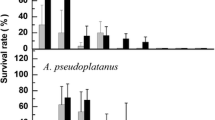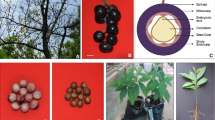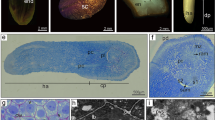Abstract
The relationships between water content of desiccated embryonic axes (using different methods of desiccation), the availability of water determined by differential scanning calorimetry (DSC) analysis and recovery percentage after liquid nitrogen (LN) exposure of Fortunella polyandra embryonic axes were investigated. The objectives were to understand thermal properties of desiccated embryonic axes during cryopreservation and to determine the critical moisture contents for successful cryopreservation of the embryonic axes. Excised embryonic axes were desiccated under laminar air flow (0, 10, 15, 30 and 45 min), over silica gel (0, 5, 15, 30 and 60 min), and ultra-rapidly (0, 5, 10, 20 and 25 min). Desiccation under laminar air flow resulted in an optimal water content of 0.150 gH2O g−1 dw and a survival of 50 % after cryopreservation, while the unfrozen water content (WCu) was 0.126 gH2O g−1 dw. After drying over silica gel, the optimal water content was 0.190 gH2O g−1 dw, where the survival was 40 % after cryopreservation and the WCu was determined as 0.177 gH2O g−1 dw. Using the flash-drying method, the optimal water content was found to be 0.145 gH2O g−1 dw, the survival was 50 % after cryopreservation and the WCu was 0.133 gH2O g−1 dw. Embryonic axes of F. polyandra showed low-to-moderate tolerance to desiccation. The results of the freezing transitions for all the desiccation times and methods showed that the onset temperature and the peak of the mean enthalpy decreased in size with decreasing water content. DSC elucidated the critical moisture contents and the cooling and melt enthalpies for successful cryopreservation of F. polyandra embryonic axes.




Similar content being viewed by others
References
Al Zoubi OM, Normah MN (2012) Desiccation sensitivity and cryopreservation of excised embryonic axes of Citrus suhuiensis cv. Limau madu, Citrumelo [Citrus paradisi Macf. x Poncirus trifoliata (L.)] and Fortunella polyandra. CryoLetters 33(3):240–250
Al Zoubi OM, Normah MN (2013) Cryopreservation of Malayan kumquat (Fortunella polyandra) embryonic axes by vitrification. Aust J of Crop Sci 7(6):758–762
Berjak P, Farrant JM, Mycock DJ, Pammenter NW (1990) Recalcitrant (homoiohydrous) seeds: the enigma of their desiccation-sensitivity. Seed Sci Tech 18:297–310
Berjak P, Pammenter NW, Vertucci CW (1992) Homoiohydrous (recalcitrant) seeds: developmental status, desiccation sensitivity and the state of water in axes of Landolphia kirkii Dyer. Planta 186:249–261
Berjak P, Vertucci CW, Pammenter NW (1993) Effects of developmental status and dehydration rate on characteristics of water and desiccation-sensitivity in recalcitrant seeds of Camellia sinensis. Seed Sci Res 3:155–166
Cho EG, Normah MN, Kim HH, Rao VR, Engelmann F (2002) Cryopreservation of Citrus aurantifolia seeds and embryonic axes using a desiccation protocol. CryoLetters 23:309–316
Crane J, Miller A, Van Roekel JW, Walters C (2003) Triacylglycerols determine the unusual storage physiology of Cuphea seed. Planta 217:699–708
Dussert S, Chabrillange N, Rocquelin G, Engelmann F, Lopez M, Hamon S (2001) Tolerance of coffee (Coffea spp.) seeds to ultra-low temperature exposure in relation to calorimetric properties of tissue water, lipid composition, and cooling procedure. Physiol Plant 112:495–504
Engelmann F (1997) In vitro Conservation Methods. In: Ford-Lloyd BV, Newbury JH, Callow JA (eds) Biotechnology and plant genetic resources: conservation and use. CAB International Publishers, Wallingford, pp 119–162
Farrant JM, Walters C (1998) Ultrastructural and biophysical changes in developing embryos of Aesculus hippocastanum in relation to the acquisition of tolerance to drying. Physiol Plant 104:513–524
Hamilton KN, Ashmore SE, Pritchard HW (2009) Thermal analysis and cryopreservation of seeds of Australian wild Citrus species (Rutaceae): Citrus australasica. C. inodora and C. garrawayi. CryoLetters 30:268–279
Hor YL, Kim YJ, Ugap A, Chabrillange N, Sinniah UR, Engelmann F, Dussert S (2005) Optimal hydration status for cryopreservation of intermediate oily seeds: Citrus as a case study. Ann Bot 95:1153–1161
Kaczmarczyk A, Zanke C, Senula A, Grübe M, Keller ERJ (2011) Thermal analyses by differential scanning calorimetry for cryopreservation of potato shoot tips. Acta Hort 908:39–46
Lambardi M, De Carlo A, Biricolti S, Puglia AM, Lombardo G, Siragusa M, De Pasquale F (2004) Zygotic and nucellar embryo survival following dehydration/cryopreservation of Citrus intact seeds. CryoLetters 25:81–90
Lehner A, Corbineau F, Bailly C (2006) Changes in lipid status and glass properties in cotyledons of developing sunflower seeds. J Plant Physiol 47:818–828
Makeen MA, Normah MN, Dussert S, Clyde MM (2005) Cryopreservation of whole seeds and excised embryonic axes of Citrus suhuienesis cv. Limau Langkat in accordance to their desiccation sensitivity. CryoLetters 26:259–268
Murashige T, Skoog F (1962) A revised medium for rapid growth and bioassays with tobacco tissue cultures. Physiol Plant 15:473–497
Nadarajan J, Mansor M, Krishnapillay B, Staines HJ, Benson EE, Harding K (2008) Applications of differential scanning calorimetry in developing cryopreservation strategies for Parkia speciosa, a tropical tree producing recalcitrant seeds. CryoLetters 29(2):95–110
Pammenter NW, Berjak P (1999) A review of recalcitrant seed physiology in relation to desiccation-tolerance mechanisms. Seed Sci Res 9:13–37
Pammenter NW, Vertucci CW, Berjak P (1991) Homeohydrous (recalcitrant) seeds: dehydration, the state of water and viability characteristics in Landolphia kirkii. Plant Physiol 96:1093–1098
Sun WQ (1999) State and phase transition behaviours of Quercus rubra seed axes and cotyledonary tissues: relevance to the desiccation sensitivity and cryopreservation of recalcitrant seeds. Cryobiology 38:372–385
Vertucci CW (1989) The effects of low water contents on physiological activities of seeds. Physiol Plant 77:172–176
Vertucci CC (1990) Calorimetric studies of rate of water in seed tissues. Biophys J 58:1463–1471
Vertucci CW, Crane J, Porter RA, Oelke EA (1994) Physical properties of water in Zizania embryos in relation to maturity status, water content and temperature. Seed Sci Res 4:211–224
Walters C, Wheeler L, Grotenhuis M (2005) Longevity of seeds stored in genebank: species characteristics. Seed Sci Res 15:1–20
Wesley-Smith J, Vertucci CW, Berjak P, Pammenter NW, Crane J (1992) Cryopreservation of desiccation-sensitive axes of Camellia sinensis in relation to dehydration, freezing rate, and the thermal properties of tissue water. J Plant Phys 140:596–604
Wolfe J, Bryant G, Koster KL (2002) What is ‘unfreezable water’, how unfreezable is it and how much is there? CryoLetters 23:157–166
Acknowledgments
This research was supported by the Ministry of Science, Technology and Environment, Malaysia, IRPA 01-03-005BTK/ER/027.
Author information
Authors and Affiliations
Corresponding author
Additional information
Communicated by M. Capuana.
Rights and permissions
About this article
Cite this article
Al Zoubi, O.M., Normah, M.N. Critical moisture content for successful cryopreservation of embryonic axes of Fortunella polyandra determined by differential scanning calorimetry (DSC). Acta Physiol Plant 37, 1727 (2015). https://doi.org/10.1007/s11738-014-1727-1
Received:
Revised:
Accepted:
Published:
DOI: https://doi.org/10.1007/s11738-014-1727-1




